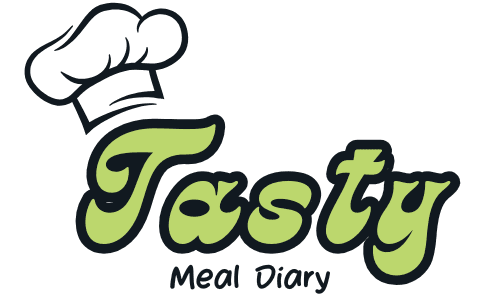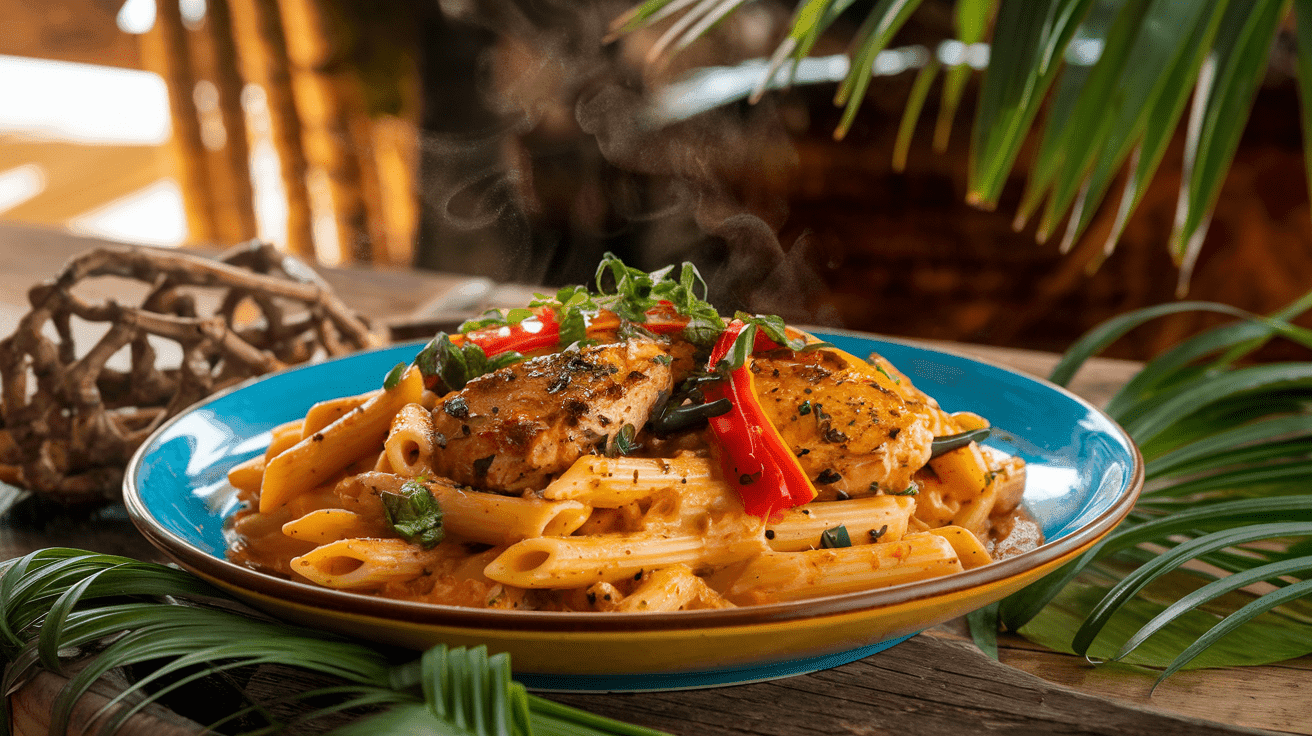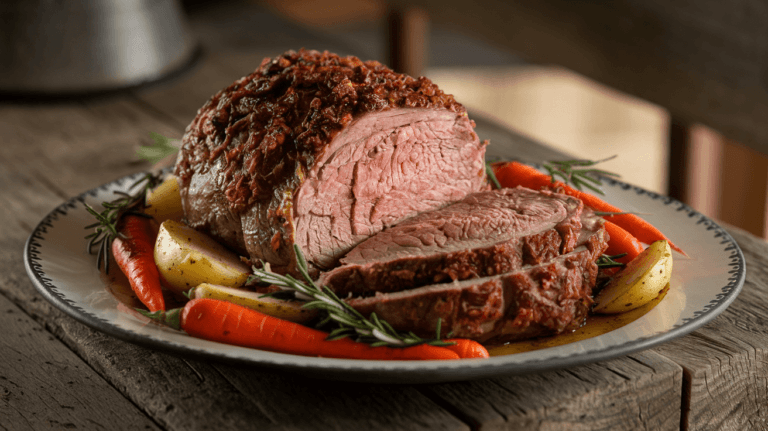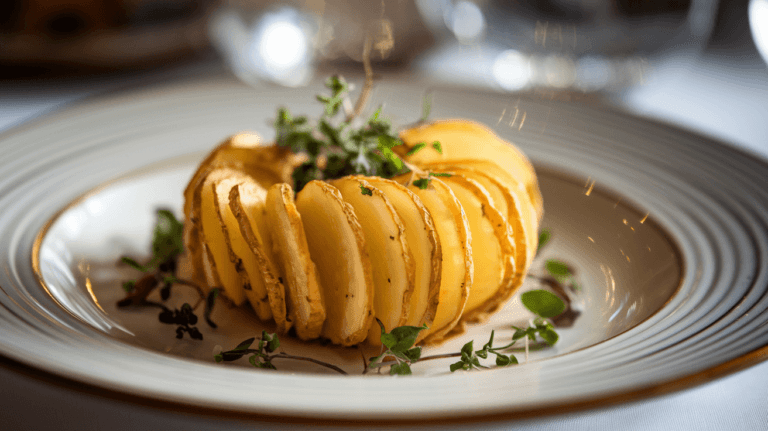Imagine a dish that blends the bold, smoky heat of jerk seasoning with the creamy richness of Italian pasta. That’s exactly what Rasta Pasta is a vibrant, spicy, and satisfying fusion of Jamaican and Italian flavors. Over the years, this dish has gained popularity for its bold seasoning, creamy texture, and endless variations, making it a favorite among food lovers.
Table of Contents
What is Rasta Pasta?
Origins of Rasta Pasta
Believe it or not, Rasta Pasta wasn’t actually created in Jamaica! According to popular belief, this colorful dish was first made in New York City by a Jamaican chef in the 1980s. The story goes that a chef prepared a creamy pasta dish for Jamaican construction workers. When they saw the vibrant colors from the bell peppers resembling the red, yellow, and green of the Rastafarian flag they playfully called it Rasta Pasta. The name stuck, and the dish quickly became a staple in Caribbean-inspired cuisine.
Though not officially a Rastafarian dish (since traditional Ital food is often vegan), Rasta Pasta can be easily modified to fit plant-based diets. Over time, it has evolved to include jerk-seasoned chicken, shrimp, and even vegan alternatives like tofu or mushrooms.
What Makes Rasta Pasta Unique?
Rasta Pasta stands out for its creamy, spicy, and smoky flavors, thanks to a combination of:
- Jerk seasoning – The heart and soul of the dish, adding a fiery, smoky kick.
- Bell peppers – Bringing sweetness, crunch, and vibrant color to the plate.
- Creamy sauce – Often made with heavy cream, coconut milk, or even dairy-free alternatives.
- Protein choices – Popular versions feature jerk chicken, shrimp, or tofu.
- Pasta – Typically made with penne, fettuccine, or rigatoni, but any pasta works!
Unlike traditional Alfredo or creamy pasta dishes, Rasta Pasta delivers a Caribbean punch bold, warm, and perfectly seasoned.
The Cultural Significance of Rasta Pasta
Though Rasta Pasta may not have originated in Jamaica, it has become an essential dish in Caribbean cuisine. Many chefs and home cooks embrace it as a symbol of cultural fusion, blending Jamaican flavors with Italian pasta traditions. The colors of the dish also pay tribute to Rastafarian culture, making it a visually striking and meaningful meal.
Additionally, vegan Rasta Pasta recipes align with Ital cuisine, a plant-based diet followed by many Rastafarians. By using coconut milk instead of dairy and tofu instead of meat, this dish can be adapted to respect traditional Rastafarian dietary principles.
Ingredients in Authentic Rasta Pasta
Traditional vs. Modern Ingredients
The beauty of Rasta Pasta lies in its versatile yet bold ingredient list. Traditional versions stick to jerk seasoning, bell peppers, and a creamy sauce, while modern variations experiment with different proteins, pasta types, and dairy-free options.
Here’s what makes up the perfect Rasta Pasta:
- Jerk seasoning – The backbone of the dish, offering spice, smokiness, and warmth.
- Pasta – Penne, rigatoni, or fettuccine work best for holding the sauce.
- Bell peppers – A must-have! Their sweet crunch complements the heat.
- Heavy cream or coconut milk – The secret to its rich and velvety sauce.
- Garlic and onions – Adding depth and aroma to the dish.
- Parmesan cheese – Gives the sauce a savory, umami kick (optional).
The Role of Jerk Seasoning in Rasta Pasta
Jerk seasoning is non-negotiable in Rasta Pasta! It brings a smoky, spicy, and slightly sweet depth to the dish. Traditionally made with a blend of:
- Scotch bonnet peppers (or habaneros for milder heat)
- Allspice, thyme, and nutmeg
- Garlic, scallions, and brown sugar
- Soy sauce or vinegar for tanginess
This mix infuses Rasta Pasta with bold Caribbean flavors, making every bite exciting and delicious.
Best Pasta Types for Rasta Pasta
Not all pasta shapes work equally well for Rasta Pasta. Some hold the creamy sauce better than others. The best choices include:
- Penne – The classic choice! The tube shape traps the sauce beautifully.
- Rigatoni – A chunkier option with grooves to hold in more sauce.
- Fettuccine – Adds a luxurious, restaurant-style feel to the dish.
Dairy vs. Dairy-Free Options
While traditional Rasta Pasta uses heavy cream and cheese, there are plenty of dairy-free alternatives for those who prefer a vegan or lactose-free version:
- Coconut milk – Adds creaminess with a subtle tropical twist.
- Cashew cream – A great homemade alternative for a rich texture.
- Nutritional yeast – Perfect for a cheesy, umami flavor without dairy.
How to Make Rasta Pasta at Home
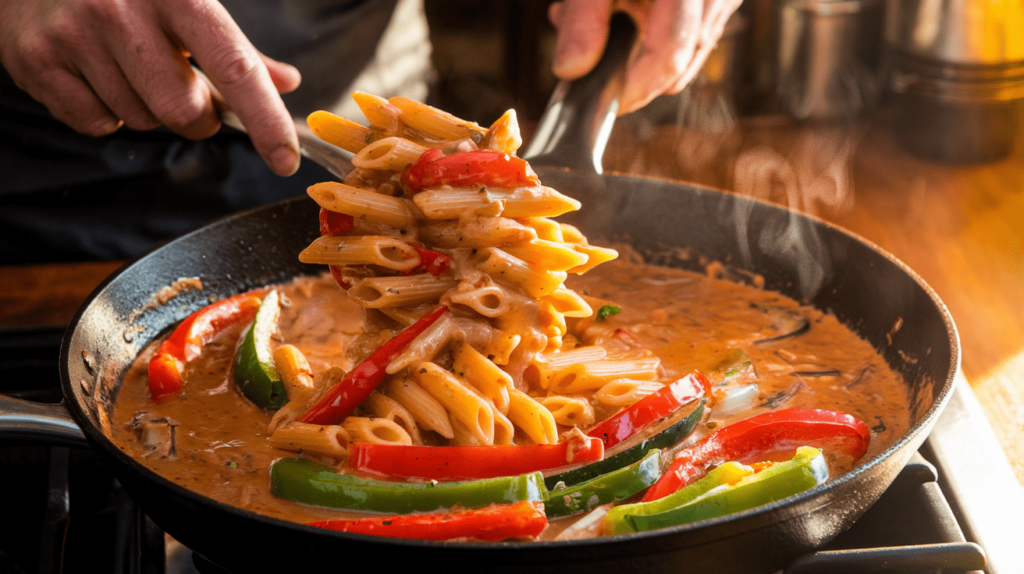
Step-by-Step Cooking Instructions
Making Rasta Pasta at home is surprisingly easy and quick! Follow these steps for a delicious, restaurant-quality dish:
- Cook the pasta – Boil penne, rigatoni, or fettuccine in salted water until al dente. Drain and set aside.
- Prepare the protein – Season chicken, shrimp, or tofu with jerk seasoning and cook in a pan until golden. Remove and keep warm.
- Sauté the aromatics – In the same pan, sauté onions, garlic, and bell peppers in a bit of oil.
- Add the creamy base – Pour in heavy cream or coconut milk, stirring to combine. Let it simmer.
- Mix in the pasta – Add the cooked pasta and toss until fully coated in the sauce.
- Return the protein – Stir in the jerk-seasoned protein, letting it soak up the flavors.
- Finish with cheese (optional) – Sprinkle in Parmesan or dairy-free cheese for extra richness.
- Serve hot – Garnish with fresh herbs, extra jerk seasoning, or lime wedges for a burst of flavor!
Vegetarian and Vegan Rasta Pasta Variations
For a plant-based version, simply:
- Swap heavy cream for coconut milk.
- Use tofu, mushrooms, or chickpeas instead of meat.
- Add extra veggies like zucchini or spinach for more texture.
The result? A creamy, spicy, and totally satisfying vegan Rasta Pasta!
Protein Choices: Chicken, Shrimp, and Tofu
Not sure which protein to use? Here’s how each one changes the dish:
- Jerk Chicken – Classic and flavorful, adding spicy, smoky bites.
- Shrimp – Cooks fast and gives a sweet, juicy contrast to the spice.
- Tofu – Perfect for a vegan-friendly, protein-packed option.
Tips for Enhancing the Flavor
Want to take your Rasta Pasta to the next level? Try these pro tips:
- Marinate proteins in jerk seasoning overnight for bolder flavor.
- Use fire-roasted bell peppers for extra smokiness.
- Add fresh lime juice before serving to brighten up the flavors.
- Spice it up with extra Scotch bonnet peppers or cayenne.
Rasta Pasta Recipe Variations
Creamy Rasta Pasta with Chicken
One of the most popular versions of Rasta Pasta includes jerk chicken. The smoky, spicy flavors of jerk seasoning pair beautifully with the rich, creamy sauce.
To make this variation, simply:
- Season chicken generously with jerk seasoning and let it marinate for at least 30 minutes.
- Sear or grill the chicken until cooked through, then slice into strips.
- Prepare the creamy sauce with garlic, onions, bell peppers, and heavy cream.
- Toss in the pasta, then mix in the sliced jerk chicken before serving.
Spicy Rasta Pasta with Shrimp
For a seafood twist, try making Rasta Pasta with shrimp! The sweet, tender shrimp balances out the heat from the jerk seasoning.
- Swap the chicken for large, peeled shrimp.
- Sauté the shrimp with butter, garlic, and jerk seasoning until pink.
- Prepare the pasta as usual and toss in the shrimp just before serving.
Vegan Rasta Pasta with Coconut Milk
Want a plant-based version of Rasta Pasta? Coconut milk makes a fantastic dairy-free alternative while keeping the dish rich and flavorful.
- Use coconut milk instead of heavy cream for the sauce.
- Add tofu, mushrooms, or chickpeas instead of meat.
- Garnish with nutritional yeast or vegan Parmesan for extra flavor.
Low-Carb and Gluten-Free Options
For a healthier twist, try these simple swaps:
- Use gluten-free pasta (like chickpea or brown rice pasta).
- Replace pasta with zucchini noodles or spaghetti squash.
- Use Greek yogurt instead of heavy cream for a lighter sauce.
Best Side Dishes and Pairings for Rasta Pasta
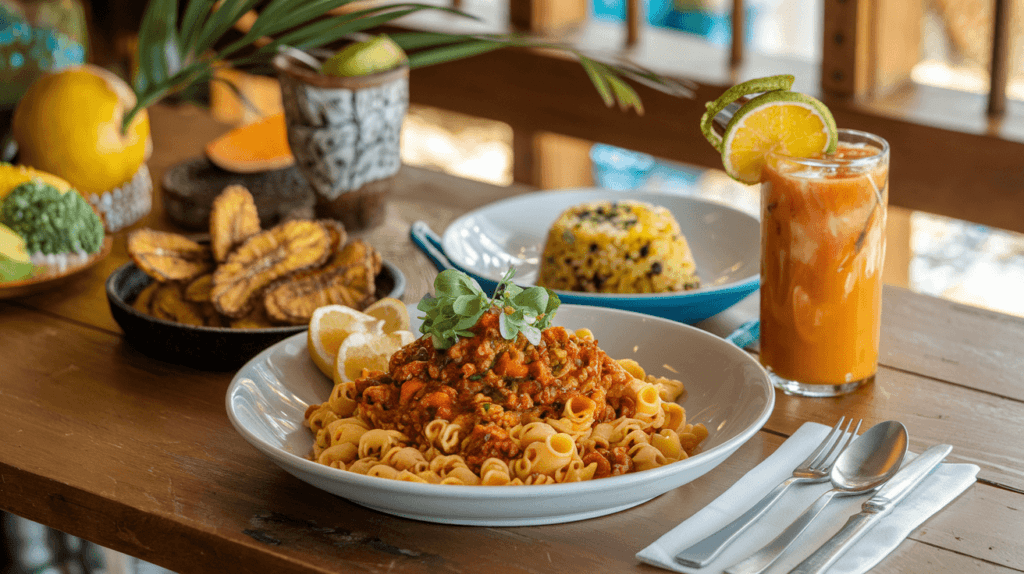
What to Serve with Rasta Pasta?
Since Rasta Pasta is already rich and flavorful, the best sides are light, fresh, and slightly sweet to balance the spice. Here are some great pairing options:
- Steamed or grilled vegetables – Broccoli, asparagus, or carrots add a refreshing crunch.
- Plantains – Fried or baked plantains bring a sweet contrast to the spicy pasta.
- Crispy garlic bread – Perfect for scooping up extra creamy sauce.
Beverage Pairings: From Rum Punch to Smoothies
Pairing the right drink with Rasta Pasta can enhance the flavors. Try:
- Jamaican rum punch – A sweet and tropical drink that complements the heat.
- Coconut water – Hydrating and refreshing, balancing the spice.
- Pineapple or mango smoothies – Naturally sweet and cooling.
Side Dishes that Complement Rasta Pasta
If you’re serving Rasta Pasta for a big meal, consider these side dishes:
- Jamaican rice and peas – A traditional side dish that pairs beautifully.
- Cornbread or festival bread – Adds a touch of sweetness to the meal.
- Avocado salad – Creamy avocado helps tone down the spice.
Nutritional Benefits and Dietary Considerations
Health Benefits of Key Ingredients
While Rasta Pasta is known for its bold flavors and creamy texture, it can also provide several nutritional benefits. The dish includes a variety of healthy ingredients that offer essential nutrients:
- Bell peppers – Packed with vitamin C, antioxidants, and fiber, they add a sweet crunch.
- Jerk seasoning spices – Ingredients like garlic, thyme, and allspice have anti-inflammatory properties.
- Protein sources – Whether you use chicken, shrimp, or tofu, the dish provides muscle-building protein.
- Pasta (whole wheat or gluten-free options) – A good source of carbohydrates that fuels energy.
Calories and Macronutrient Breakdown
The caloric content of Rasta Pasta depends on the ingredients used. A standard serving with creamy sauce and protein contains:
- Calories: 500-700 per serving
- Protein: 25-40g (varies by protein choice)
- Carbs: 50-70g (can be reduced with gluten-free pasta)
- Fats: 20-30g (lower with dairy-free alternatives)
How to Make Rasta Pasta Healthier?
If you want a lighter version of Rasta Pasta, try these simple swaps:
- Use coconut milk instead of heavy cream for a lower-fat alternative.
- Opt for whole wheat or chickpea pasta to boost fiber and protein.
- Increase vegetables by adding spinach, zucchini, or mushrooms.
- Reduce cheese or use nutritional yeast for a dairy-free, lower-calorie option.
The Popularity of Rasta Pasta in Restaurants
How Rasta Pasta Became a Trend
Over the past decade, Rasta Pasta has exploded in popularity, especially in Caribbean and fusion restaurants. What started as a humble home-cooked dish has now become a menu favorite across the globe.
Thanks to its Instagram-worthy colors, bold flavors, and versatility, food lovers everywhere are embracing this Jamaican-Italian fusion dish. It’s especially popular in New York, Miami, and London, where Caribbean cuisine thrives.
Top Restaurants Serving Rasta Pasta
Many restaurants now offer their own unique spin on Rasta Pasta. Some of the most famous spots to try it include:
- Miss Lily’s (New York & Dubai) – Known for its creamy, jerk-infused pasta with shrimp.
- Negril ATL (Atlanta, GA) – Serves a rich and spicy version with chicken or tofu.
- Dutch Pot Jamaican Restaurant (Florida) – Features an authentic, smoky jerk pasta dish.
Homemade vs. Restaurant Rasta Pasta
While ordering Rasta Pasta from a restaurant is convenient, making it at home allows for personalized flavors and healthier choices. Plus, you can control the spice level, protein type, and creaminess to suit your taste.
Whether you prefer a classic restaurant version or a homemade twist, Rasta Pasta remains a beloved fusion dish that continues to gain fans worldwide!
FAQs
1. What does Rasta Pasta taste like?
Rasta Pasta is a bold, creamy, and slightly spicy dish that perfectly blends Caribbean and Italian flavors. The rich sauce, infused with jerk seasoning, delivers a smoky, slightly sweet, and fiery kick. Meanwhile, the bell peppers add a fresh, crisp contrast, and the Parmesan or coconut milk enhances the savory, creamy texture. Whether made with chicken, shrimp, or tofu, the dish always packs a flavorful punch.
2. Can I make Rasta Pasta without jerk seasoning?
Yes! While jerk seasoning is key to its authentic taste, you can still create a delicious version without it. Try using:
- Cajun seasoning for a milder, smoky kick.
- Paprika, garlic powder, thyme, and chili flakes as a homemade substitute.
- Harissa or chipotle powder for a different kind of heat.
That said, if you want true Rasta Pasta flavor, it’s best to use authentic jerk seasoning!
3. Is Rasta Pasta considered Jamaican food?
Rasta Pasta has Jamaican-inspired flavors, but it isn’t a traditional Jamaican dish. It was created in New York City by a Jamaican chef in the 1980s. Over time, it became widely associated with Caribbean cuisine due to its jerk seasoning, bold spices, and vibrant colors. While it may not be authentic Jamaican food, it is heavily influenced by the island’s flavors.
4. What is the best pasta to use for Rasta Pasta?
The best pasta for Rasta Pasta is one that holds sauce well. Here are some great options:
- Penne – A classic choice that soaks up the creamy sauce.
- Rigatoni – A larger, ridged pasta that traps flavor.
- Fettuccine – Perfect for a luxurious, restaurant-style version.
Why You Should Try Rasta Pasta Today!
A Fusion of Bold Flavors
Rasta Pasta is more than just a pasta dish it’s a celebration of Caribbean and Italian flavors in one vibrant meal. The smoky jerk seasoning, the creamy, rich sauce, and the fresh bell peppers make every bite a burst of bold, irresistible taste. Whether you prefer it with chicken, shrimp, or a vegan twist, this dish is incredibly versatile and customizable.
Easy, Quick, and Absolutely Delicious
One of the best things about Rasta Pasta is how quick and simple it is to make at home. In just 30 minutes, you can have a restaurant-quality meal that’s both comforting and exciting. Plus, with so many variations, there’s a version for every diet and preference!
Try It Today!
Whether you’re craving a spicy, creamy pasta dinner or looking to explore new fusion dishes, Rasta Pasta is a must-try. Its rich history, flavorful ingredients, and easy preparation make it a dish you’ll want to cook again and again. So, why wait? Try making Rasta Pasta today and bring the taste of the Caribbean into your kitchen!
If you’re looking for more tasty recipes, check out our collection of delicious meal ideas!
